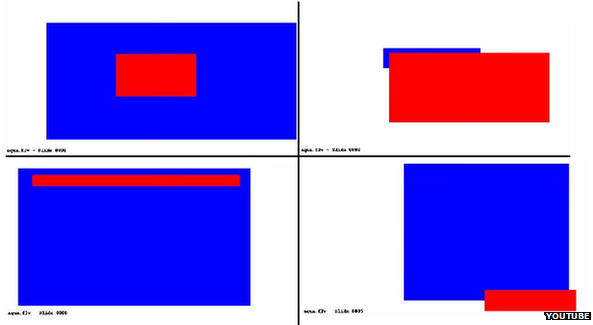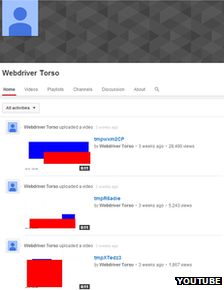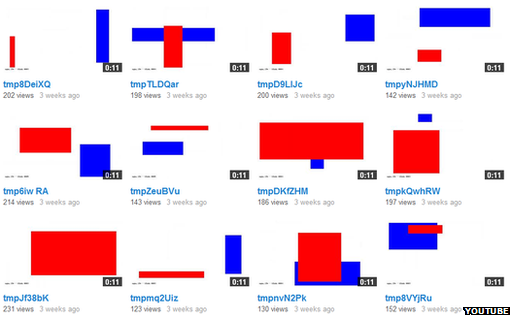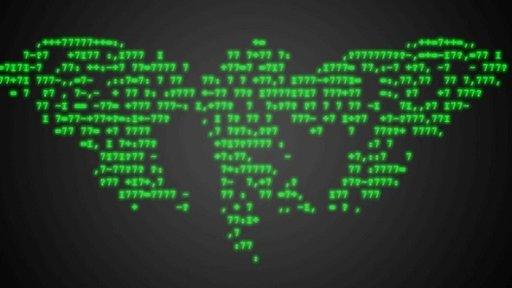Webdriver Torso YouTube mystery clips' French connection
- Published
- comments
BBC Click's Spencer Kelly devles into the Webdriver Torso mystery
On 23 September 2013 at 14:45, YouTube user Webdriver Torso quietly uploaded a video.
The mysterious 11-second sequence, external of red and blue rectangles could easily have been lost, unexplained and unappreciated among YouTube's plethora of kittens and music videos.
But 28 minutes later Webdriver, external uploaded an almost identical video, and another an hour after that, and another, until eight months later - apparently happy with nearly 80,000 clips - they fell silent, with 236 hours of video to their name.
Almost all of the uploads follow the same pattern - 10 slides, each with a red rectangle, a blue rectangle and a computer-generated tone.
The shapes change size and the notes change pitch. Each video appears to be unique, but the format stays the same.

These stills, from four different videos, are typical of the shapes and colours shown
Wired magazine first stumbled on the clips in February, external as part of a feature on obscure YouTube uploads.
Spy messages?
People have since started to wonder what it could all possibly mean. Who is Webdriver Torso? What do they want from us?
The Boing Boing blog suggested, external Webdriver could be the next generation of number stations.
Thought to be used to pass secret communications to spies in the field, number stations broadcast unintelligible lists of numbers or letters in Morse code over shortwave radio - accessible, but meaningless to everyone but the intended recipient, who possesses the decryption codes.
Or could it be the latest iteration of Cicada 3301 or another such public challenge - intensely difficult puzzles set up by an anonymous organisation, thought to be part of a test designed to recruit undiscovered cryptographic talent.

It has been speculated that the clips could be the modern equivalent of number sequences read out and broadcast over shortwave radio
Perhaps it could it be a piece of stray automation software?
The channel shares part of its name with Selenium WebDriver, a tool used to test websites.
A member of the Selinium WebDriver development team, however, denied it had anything to do with the clips, telling news site The Daily Dot, external that they could well be extraterrestrial uploads from aliens. Aliens who use YouTube that is.
A related explanation was, external put forward by the Guardian, which spoke to software engineer Isaul Vargas. He said he'd seen a video of these patterns - created by set-top box provider YouView - filmed at a conference.
However, when the BBC spoke to Mr Vargas he acknowledged he had been mistaken: "I found the video and when I re-watched it I found that wasn't the case, it had a different test pattern."
However, he added that he still thought that the patterns could be the result of some sort of automated tests.
Clip code
As a geek and professional obsessive for BBC tech programme Click, it was a mystery I couldn't leave unexplored.

Webdriver Torso's YouTube account ceased activity three weeks ago
So, with my curiosity overwhelming my desire to go outside, I set about analysing Webdriver.
Many online services such as YouTube allow developers to access the data behind their websites through something called an Application Programming Interface (API).
YouTube's API lets you download much of the data connected with videos on the site, including the name, duration and description of the clips.
By automatically making hundreds of API requests, you can very quickly download the data of thousands of videos.
In about an hour I had the data on every video posted by Webdriver since the account was created.
Having all this information in one place meant that I could do some analysis to see if there were any patterns.
Tireless worker
A few graphs later and I had confirmed that Webdriver was a prolific worker.
At the peak, over Christmas, Webdriver was uploading a video on average every two minutes, presumably in between opening presents.
Webdriver also never sleeps, uploading about 400 videos on most days, every day Monday to Sunday.
I then turned my gaze to looking for anomalies in the data, discovering that of the tens of thousands of videos on the channel, they are all exactly the same length, except for two.

The video clips of the boxes are all 11 seconds long
The very first video uploaded, external to the channel, over a month before the first rectangle classic, reveals a completely different side to Webdriver.
Locked behind a 1.99 euro ($2.76; £1.63) paywall and only accessible if you're in France, is a clip from the cartoon series Aqua Teen Hunger Force, in which the show's three anthropomorphic fast-food items - Frylock, Meatwad and Master Shake - fail to win a pub quiz.
The second anomalous clip only raises more questions.
In video 1,182 we have what could be our first sighting of Webdriver.
Filmed from a Parisian balcony, the six-second clip, external shows an Eiffel Tower lightshow followed by a fleeting glimpse of a face.
Below the video, Webdriver has left a comment, their only known communication with the world: "Matei is highly intelligent."

This view of the Eiffel Tower was uploaded by the same account
Efforts to contact the author through their Google+ account went unanswered.
So what do you think?
Automation software gone rogue, cartoon-loving aliens or the next generation of clandestine communications?
One thing's for sure, there's a lot of French in this mystery.
The Eiffel tower, thousands of tricolore rectangles and a talking bucket of French fries.
If it is indeed aliens, let's hope they viennent en paix (come in peace).
Update 2 May: After three weeks of silence Webdriver has resurfaced to upload a new video, entitled tmpdKHvbS, external. It follows the same format as the 77,387 videos before it. However, for the first time the account holder also liked their own video - an action that suggests there is more to this than an automated piece of software.
- Published16 April 2014

- Published9 January 2014

- Published7 February 2013